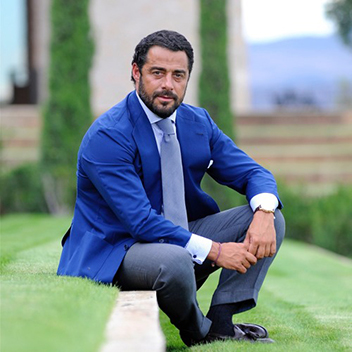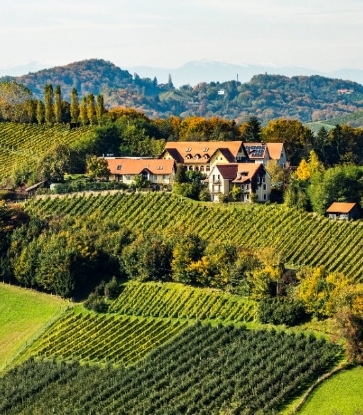The reputation of Marqués de Murrieta, and its Ygay Estate, is as old as it is illustrious. Founded in Rioja in 1852 by Luciano de Murrieta y Garcia-Lemoine, who held the royal title of Marqués de Murrieta, Marqués de Murrieta was first established in Logroño and is the oldest operating winery in Rioja. And, while it’s true that longevity is a component of its prestige, the arrival of Garcia-Lemoine also represented a turning point for the region in terms of both technique and the quality of the wines being created. Prior to opening his winery, Garcia-Lemoine spent time in Bordeaux learning how to make wines of a finer character than was typical for the time, and those skills were put to good use in Rioja.
Nearly 100 years later in 1983, the estate and the 3,000-square-meter granite palace that shares the same name were purchased by Vicente Cebrián, the Conde (Count) de Creixel. Only three years later, Cebrián died suddenly and unexpectedly of a heart attack, leaving his son, Vicente Dalmau Cebrián-Sagarriga, as the inheritor of the estate and in charge of the business.

It was a very challenging time for the young Cebrián-Sagarriga and he weathered it partially by building a stellar team, including his talented head winemaker, María Vargas, who joined the winery in 1995. Cebrián-Sagarriga also invested heavily in updating the winery and its existing structures, to date spending approximately $60 million on the project. However, this investment also came with its own challenges: how do you innovate and update a winery with such historical importance without disrupting the existing traditions and heritage?
The following interview has been edited for length and clarity.
What was it like when you became the owner of the winery?
My life changed in 1986 when my father passed away when he was really young, 47 years old, from a heart attack. I was quite young, just 24 years old, and had just finished my education. Although, I was quite involved in the wineries because I had come to work with my father when I was even younger. I began to work at the winery while I was studying at the University of Navarra. I remember perfectly when I was 18 years old I was in my first course at the university and my father called me and told me, "Dalmau, I confirmed that our export director is not going to work any more with us." I asked him, "Did you find another one?" and he said, "I found another one: it's you."
How did you feel about that?
At that moment I hated my father. I'm working with [him] at the winery, but I need to be at the university, I need my time here. But he was tough, he said no. He said I need to finish my education but I need to work with him and to travel.
Was that hard?
In one way it was difficult, and in another way it was really attractive. When I was 18 years old I'd already visited 50 different markets and countries. Was it easy? No. But it was really, really attractive in the way that I was educated. Not many people who are that age have worked in 50 different markets and countries. So you have these two opposite ways of looking at this: difficult and hard, and at the same time, unique and nice.
When my father died, and it was like two shocks. The first shock is inside your family. I had three sisters younger than me, plus my mother was really young. To lose a father so young . . . And then the second shock is in a professional way, as the boss of a lot of companies that my father owned. Not just the winery—he was also involved in real estate and in a lot of other companies. He was the only one, and then everyone was looking at me.
What kind of changes have happened at Marqués de Murrieta?
I decided to concentrate 100% on wine. I hired a new team to work with me on the wine, a young, young team that were really feeling and thinking the same things about wine. After this new young team came on I decided to move forward to update the whole project. I began with the wines and updated all of the different styles inside Murrieta. I decided that it was really important to do it in a slow way. It's not good for the wine, for the winery, to do it in a rushed way. I decided I needed a minimum of 10 or 12 years.
Meanwhile, I decided to begin to show the market what we wanted to do. I decided to release another wine, Dalmau, and it was like a shock for the legacy of Murrieta—the first winery in Spain, the first winery in Rioja that is known for making a classic style of wines. It was a modern style of Rioja, far away from the concept of Rioja, far away from the typical taste of Rioja. We created this—it was made in a totally different way. We began to show that we wanted to produce wines with a lot of fruit, less oak, younger oak, and more balance between oak and barrel. Trying to send a message that there's a new era of Marques de Murrieta.
What was the reaction like?
I think the market had two reactions. One reaction was when the wine was analyzed just as a wine, and the market was really in love with the wine. But there was a second reaction when they realized that the wine was coming from Marques de Murrieta. Some people were really attracted to the idea, but some people criticized that a classic concept like Murrieta was doing something like this.
Have things changed significantly at the winery?
The identity of our wines is still there. I didn't change anything, I mainly updated many things that I thought were not ideal for the new era. It was too big to change things completely. When you've worked for 160 years there's no sense in changing many things. You need to update, you need to bring your winery, your wines, your project, to the year in which you're living. When I use the word "change" I use it in this sense: I changed everything so that it would stay the same.
Photos courtesy of Marqués de Murrieta.




















